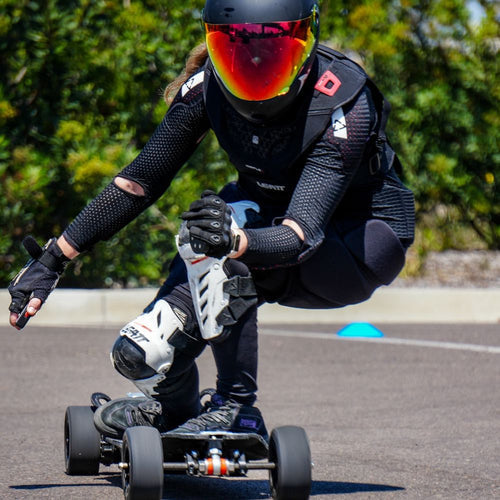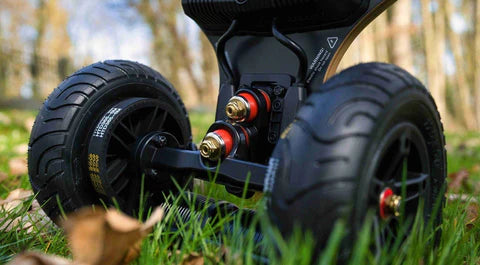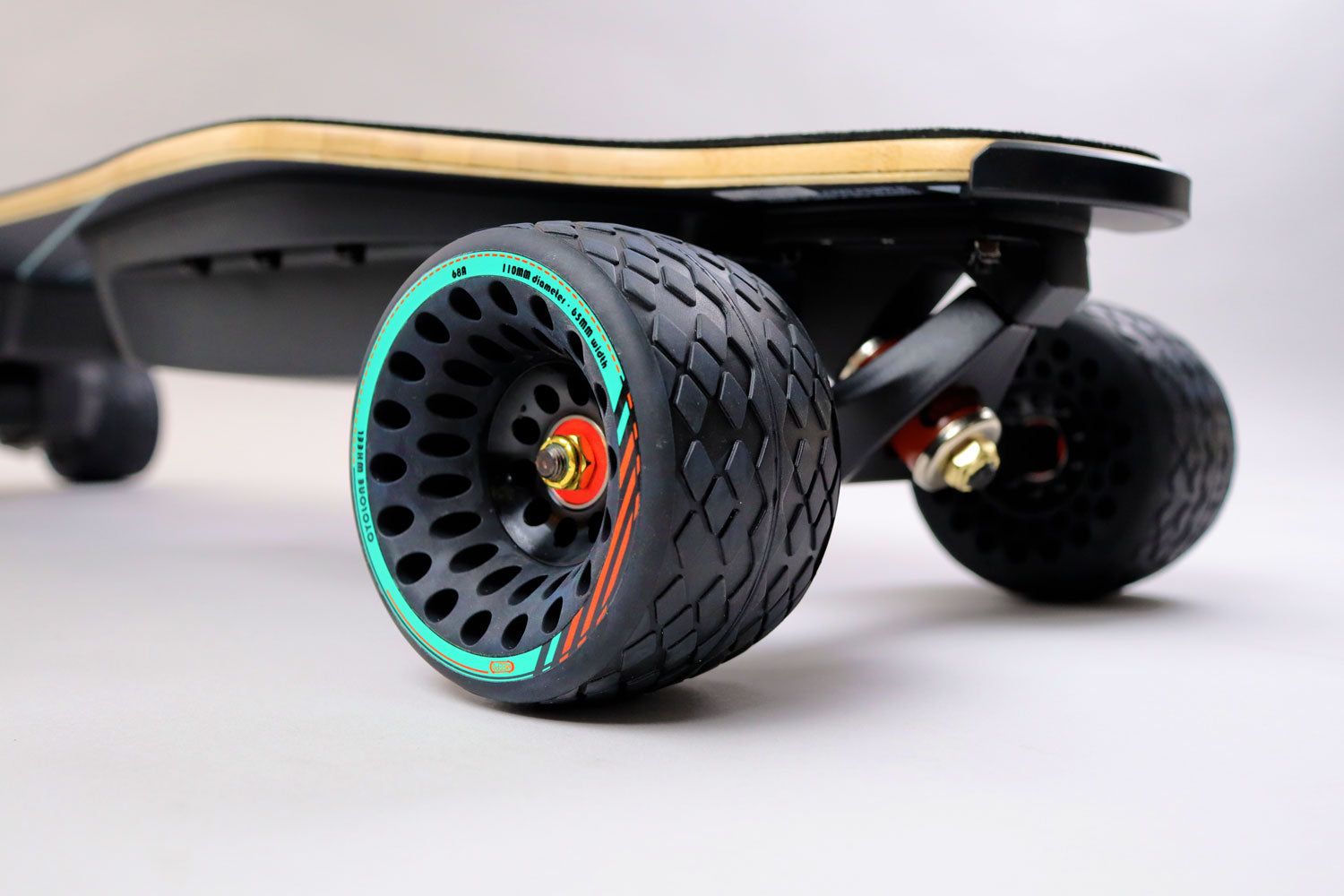The thrill of cruising down city streets on an electric skateboard is undeniable. But when the path ahead starts to climb, many riders face a moment of uncertainty. Can their board handle that steep hill ahead? After all, not all electric skateboards are created equal when it comes to conquering inclines. This guide will break down everything you need to know about electric skateboards and their ability to tackle those challenging uphill battles.
Can Your Electric Skateboard Really Conquer Those Hills?
Yes, absolutely! Modern e-skateboards can handle hills surprisingly well - and we're not just talking about gentle slopes. The technology has advanced so much that many of today's boards can power up some seriously steep inclines. To put this in perspective, a quality electric skateboard can tackle slopes between 15-30% grade.
But here's the catch - just like cars have different engine powers, electric skateboards come with varying capabilities. Your success on hills depends on several important factors, which we'll explore in detail. Learning these elements will help you choose the right board or make the most of the one you already have.

What Factors Affect an Electric Skateboard's Uphill Performance
Knowing what makes your electric skateboard good at hill riding is important for both picking out the right one and getting the most out of it. Let's look at the key factors that affect how well your electric skateboard can tackle those challenging slopes.
Motor Power and Torque
Higher-wattage motors generate more torque, which is necessary for powering up steep inclines. When it comes to motor types, belt-drive motors typically have an edge over hub motors in climbing performance. They can deliver more torque to the wheels, giving you that extra push when the terrain gets challenging. For serious hill climbers, dual-motor setups offer even more power and better weight distribution, making them ideal for tackling the steepest grades.
Battery Capacity and Voltage
The battery is the heart of your electric skateboard, and its specifications directly impact hill-climbing ability. The higher the voltage (usually between 36V to 42V), the more power your board has for tackling steep hills. But voltage isn't everything - battery capacity (measured in Ah) determines how long your board can maintain that performance. For example, a 42V battery with 10Ah capacity typically offers better hill-climbing performance than a 36V 6Ah battery, allowing riders to tackle steeper grades for longer periods.
Rider Weight
Your weight plays a huge role in how much power you'll need to climb hills effectively.
| Rider Weight | Recommended Motor Power | Recommended Meepo E-Skateboard Models |
| Under 150lbs | 1000W-1500W | Meepo Go |
| 150-200lbs | 1500W-2500W | Voyager |
| Over 200lbs | 2500W+ | VADER |
Keep in mind that these are just starting points - your local terrain and riding style might call for more or less power.
Wheel Size and Traction
Your wheels are where the rubber meets the road - literally. Larger wheels between 85-120mm give you better stability when climbing, while softer wheels (rated 75a-85a) provide more grip. For wet conditions or rough terrain, pneumatic (air-filled) tires are your best bet. They might be heavier, but the extra traction they provide can make all the difference on tricky inclines.
Slope Gradient
Hills come in all shapes and sizes, and your board's ability to handle them varies accordingly.
- Most entry-level boards can handle gentle slopes of 5-10% without breaking a sweat.
- When you get into the 10-20% range, you'll want a mid-range board with dual motors.
- For those really steep hills (20-30%), only high-end boards with powerful motors will do the job reliably.
What Are the Limitations of Electric Skateboards on Steep Hills?
Though electric skateboard can handle the hills, it still has its limits, which mainly include:
Reduced Speed on Steep Inclines
It takes more power for motorized skateboards to beat gravity as the slope of a hill rises, which leads to a big drop in speed. Some high-performance boards may be better at this, but budget or low-power types can really slow down or even stop on very steep slopes.
Increased Battery Drain
Riding up hills uses a lot more energy than riding on flat ground, so the battery dies faster. This restricts the skateboard's range, especially when riding uphill for a long time. After climbing steep hills, riders may need to recharge sooner than expected.
Motor Overheating
Continuously going up hills puts extra stress on the motor, which can cause it to get too hot. This is particularly common in boards with lower wattage motors or cooling systems that aren't good enough, which could cause performance issues or long-term damage.
Traction Challenges
Wheels may lose their grip on rough or steep slopes, especially if they were not made to be used off-road. This can make it hard to stay stable and in control while climbing. Under these conditions, all-terrain or pneumatic tires work best, but they might not come stock on all boards.
Gradient Limitations
Most motorized skateboards can handle slopes of 10 to 20 degrees, and high-performance types can handle slopes of up to 30%. Anything steeper may exceed the board's capabilities, causing it to stall or fail altogether.

How Can You Maximize E-skateboard's Hill-Climbing Performance?
Even if you don't have a top-tier board, mastering the right techniques can significantly improve your hill-climbing abilities.
Master the Momentum Approach
Don't start your climb from a standstill if you can help it. Build up speed on the flat section before the hill - this initial momentum is like having a running start. Aim for a comfortable speed of 12-15 mph before hitting the incline. This technique reduces the strain on your motor and battery while making the climb more efficient.
Perfect Your Riding Stance
Lean forward at about 15 degrees when climbing. Your forward lean helps maintain traction and keeps your weight balanced over the front truck. Keep your knees slightly bent to absorb any bumps and maintain better control. Think of it as pushing your body weight in the direction you want to go.
Maintain Your Board Like a Pro
Regular maintenance makes a huge difference in climbing performance:
- Clean your wheels weekly - dirt and debris reduce grip
- Check tire pressure before each ride (if using pneumatic tires)
- Keep your belts properly tensioned (for belt-drive systems)
- Regularly inspect and clean your bearings
A well-maintained board can perform significantly better than a neglected one on hills.
Master Throttle Control
Smooth, consistent throttle input is key. Avoid the temptation to slam the throttle to full power - this can actually reduce traction and efficiency, and the sudden jerks could lead to loss of control or balance. Instead, apply about 75% throttle and adjust based on the hill's steepness.
Choose the Right Line
Pick your path carefully. Look for:
- The smoothest section of the road
- Areas with better pavement grip
- Less steep sections of the hill (if available)
- Avoid loose gravel or wet leaves
Sometimes, zigzagging slightly can help reduce the effective grade of the hill, making it easier to climb.
Know Your Battery Levels
Start challenging hills with at least 50% battery charge. Hill climbing demands more power, and voltage sag becomes more noticeable with lower battery levels. This means your board's performance can drop significantly when the battery is low, even if you still have some range left.
Which Features Should You Look for in a Hill-Climbing E-Board?
Choosing the right electric skateboard for hilly terrain requires careful consideration of several key features. Let's see what specifications and characteristics make for an excellent hill-climbing board.
| Category | Feature | Recommended Specs | Why It Matters |
| Motor System | Power Output | 2000W+ (dual motors) | Higher power enables steeper climbs |
| Motor Type | Belt-drive system | Better torque delivery than hub motors | |
| ESC | Advanced with custom profiles | Allows optimization for hill climbing | |
| Battery | Configuration | Minimum 10S (37V) | Higher voltage means more power |
| Capacity | 10Ah+ | Ensures sustained climbing performance | |
| Cell Quality | Samsung/LG/Sanyo | Reliable power output, better voltage stability | |
| BMS | Advanced management system | Protects battery, optimizes performance | |
| Wheels | Size | 85-100mm | Balance of torque and obstacle clearance |
| Material | PU (85a-90a) or rubber | Provides necessary grip for climbs | |
| Gear Ratio | Higher teeth count on wheel pulley | Optimizes torque over speed | |
| Traction | Deep treads/textured surface | Ensures grip on various surfaces | |
| Construction | Deck Material | Carbon fiber/reinforced bamboo | Durability and flex control |
| Suspension | Built-in or upgradable | Improves control and stability | |
| Braking | Regenerative + mechanical | Safe descents, energy recovery | |
| Weight Distribution | Balanced design | Better traction and control |
Note: You can use this table as a checklist when shopping for your hill-climbing e-skateboard. Go through each feature and tick off which ones your potential board meets. This will help you make an informed decision based on your specific needs and the terrain you'll be riding on. While it's great to have all these features, you may not need every single one depending on your local hills and riding style.

FAQs:
How Does Regular Hill Climbing Affect Your Board's Longevity?
Regular hill climbing can shorten the life of an electric skateboard by putting stress on the battery, motor, and ESC, which can cause them to overheat and wear out faster. It increases battery discharge cycles and friction on wheels and drivetrain components, so they need to be serviced more often to avoid breakdowns and keep the performance up.
Can You Upgrade Your Electric Skateboard for Better Hill-Climbing Ability?
Yes, you can enhance your e-board's hill-climbing performance through several upgrades. Here are the key modifications:
| Upgrade Category | Upgrade Category |
| Motor |
- Replace stock motors with higher wattage versions - Switch from hub motors to belt-drive system (if possible) - Upgrade motor pulleys for better gear ratios - Install dual motors if your board supports it |
| Battery |
- Upgrade to a higher voltage battery system - Increase battery capacity (larger amp-hours) - Switch to higher-quality battery cells - Install a better Battery Management System (BMS) |
| Wheel |
- Install all-terrain wheels for better traction - Optimize wheel size for torque - Use wider wheels for increased stability |
| Electronics |
- Install a more powerful ESC - Update firmware for better power delivery - Add a voltage display for battery monitoring - Upgrade remote control for better throttle control |
| Mechanical |
- Install better bearings for reduced resistance - Upgrade trucks for improved stability - Add shock pads for better grip - Optimize belt tension (for belt-drive systems) |
Is It Worth Investing in Off-Road Wheels or Additional Batteries for Steeper Climbs?
Making informed decisions about upgrading your electric skateboard requires weighing the costs against the benefits. Here's the analysis table:
| Aspect | Off-Road Wheels | Additional Batteries |
| Primary Benefit | Improved traction and terrain handling | Extended range and sustained power |
| Key Advantages |
- Better grip on various surfaces - Easier obstacle handling - Improved shock absorption - Increased versatility for different terrains |
- Longer ride times - Consistent power on multiple climbs - Reduced voltage sag - Ability to swap for extended trips |
| Potential Drawbacks |
- Slight reduction in torque - Decreased overall range - May require board modifications |
- Added weight to the board - Requires proper battery management - Potential need for board modifications |
| Best For | Riders frequently encountering rough or varied terrain | Riders tackling multiple long climbs or needing extended range |
| Impact on Climbing | Improves performance on unpaved or slippery inclines | Maintains power output for longer/multiple climbs |
| Compatibility Concerns | Check wheel size limitations and motor mount clearance | Ensure board can accommodate additional battery weight/size |
| Cost Consideration | Generally lower initial investment | Often more expensive, especially for quality cells |
| Maintenance | Regular cleaning and occasional replacement | Proper charging, storage, and eventual replacement |



